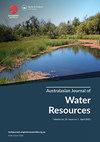水平串联过滤在灰水处理中的应用半工业性研究
IF 2.2
Q2 WATER RESOURCES
引用次数: 7
摘要
摘要灰水是非饮用用水的重要替代水源之一,但需要去除污染物。本研究的目的是研究由沙子、沸石(Z)、浮石(P)和颗粒活性炭(GAC)组成的卧式系列过滤器(HSF)的性能,以分析伊朗Fasa大学学生宿舍灰水中样品的化学需氧量(COD)、生化需氧量(BOD5)、总溶解固体(TDS)、浊度和pH值。将灰水通过过滤器进行再循环处理。经过最后一次过滤后,处理过的灰水返回主水箱。系统以2.94 m3 day−1的过滤速率运行。过滤试验数据分析表明,GAC是去除灰水中COD、BOD5和TDS效果最好的吸附剂,沸石次之。而浮石更适合用于去除浊度。然而,由于过滤器中吸附剂的质量不同,浮石比沸石表现出更高的吸附能力。总体而言,GAC+Z + P组合对COD、BOD5、TDS和浊度的降低效果最佳,分别达到90.42%、91.43%、82.95%和90.27%。因此,所研究的系统可以在公共场所实施中水处理和回用。本文章由计算机程序翻译,如有差异,请以英文原文为准。
Application of horizontal series filtration in greywater treatment: a semi-industrial study
ABSTRACT One of the important alternative water sources for non-potable purposes is greywater, but needs to remove contaminants. The aim of this study was to investigate the performance of a horizontal series filter (HSF) consists of sand, zeolite (Z), pumice (P), and granular activated carbon (GAC) to analyse the chemical oxygen demand (COD), biochemical oxygen demand (BOD5), total dissolved solids (TDS), turbidity, and pH in greywater samples from Fasa University Student Hostel, Iran. Recycling treatment was performed by passing the greywater through filters. After the last filter, treated greywater was returned into the main tank. The system was run at filtration rate of 2.94 m3 day−1. The analysis of the data from the filtration tests showed that GAC is the best adsorbent for removing COD, BOD5, and TDS from greywater, followed by zeolite. Whereas, pumice is more advisable to remove turbidity. However, due to the different mass of adsorbents in the filters, pumice showed a higher adsorption capacity than zeolite. Generally, the triple combination of GAC+Z + P represented the best performance in the reduction of COD, BOD5, TDS, turbidity up to 90.42%, 91.43%, 82.95%, and 90.27%, respectively. Therefore, the studied system can be implemented in public places to greywater treatment and reuse.
求助全文
通过发布文献求助,成功后即可免费获取论文全文。
去求助
来源期刊

Australasian Journal of Water Resources
WATER RESOURCES-
CiteScore
5.10
自引率
21.90%
发文量
25
期刊介绍:
The Australasian Journal of Water Resources ( AJWR) is a multi-disciplinary regional journal dedicated to scholarship, professional practice and discussion on water resources planning, management and policy. Its primary geographic focus is on Australia, New Zealand and the Pacific Islands. Papers from outside this region will also be welcomed if they contribute to an understanding of water resources issues in the region. Such contributions could be due to innovations applicable to the Australasian water community, or where clear linkages between studies in other parts of the world are linked to important issues or water planning, management, development and policy challenges in Australasia. These could include papers on global issues where Australasian impacts are clearly identified.
 求助内容:
求助内容: 应助结果提醒方式:
应助结果提醒方式:


